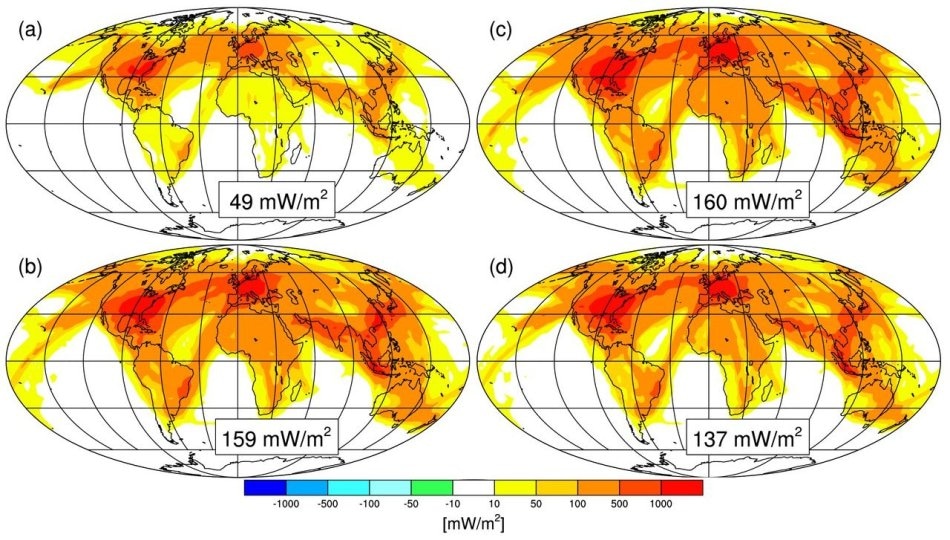Jun 28 2019
In the appropriate conditions, airplane contrails tend to remain in the sky as contrail cirrus – ice clouds that can trap heat inside the Earth’s atmosphere. Their climate impact has been mostly ignored in global schemes to counterbalance aviation emissions, even though contrail cirrus have added more to warming the atmosphere than all CO2 released by aircraft since the beginning of aviation.
 (Image credit: Bock and Burkhardt, Atmos. Chem. Phys., 2019)
(Image credit: Bock and Burkhardt, Atmos. Chem. Phys., 2019)
A new research published in the European Geosciences Union (EGU) journal Atmospheric Chemistry and Physics has discovered that, because of air traffic activity, the climate impact of contrail cirrus will be even more substantial in the future, tripling by 2050.
Contrail cirrus alters universal cloudiness, which causes an imbalance in the Earth’s radiation budget – known as “radiative forcing” – that results in planet warming. The greater this radiative forcing, the more extensive the climate impact. In 2005, air traffic accounted for about 5% of all anthropogenic radiative forcing, with contrail cirrus being the biggest contributor to aviation’s climate impact.
“It is important to recognise the significant impact of non-CO2 emissions, such as contrail cirrus, on climate and to take those effects into consideration when setting up emission trading systems or schemes like the Corsia agreement,” says Lisa Bock, a researcher at DLR, the German Aerospace Center, and the new study’s lead author. Corsia, the UN’s scheme to counterbalance air traffic carbon emissions from 2020, disregards the non-CO2 climate impacts of aviation.
But the new Atmospheric Chemistry and Physics study indicates these non-CO2 climate impacts cannot be ignored. Bock and her colleague Ulrike Burkhardt forecast that contrail cirrus radiative forcing will be three times larger in 2050 than in 2006. This increase is projected to be faster than the rise in CO2 radiative forcing since anticipated fuel efficiency measures will lower CO2 emissions.
The increase in contrail cirrus radiative forcing is because of the increase in air traffic, expected to be four times larger in 2050 compared to 2006 levels, and a minor shift of flight routes to higher altitudes, which favors the development of contrails in the tropics. The impact on climate because of contrail cirrus will be greater over Northern America and Europe, the busiest air traffic regions in the world, but will also considerably increase in Asia.
“Contrail cirrus’ main impact is that of warming the higher atmosphere at air traffic levels and changing natural cloudiness. How large their impact is on surface temperature and possibly on precipitation due to the cloud modifications is unclear,” says Burkhardt.
There are still some uncertainties regarding the overall climate impact of contrail cirrus and in particular their impact on surface temperatures because contrail cirrus themselves and their effects on the surface are ongoing topics of research. But it’s clear they warm the atmosphere.
Lisa Bock, Study Lead Author and Researcher, DLR, German Aerospace Center
Cleaner aircraft emissions would partially solve the issue emphasized in the research. Reducing the volume of soot particles produced by aircraft engines cuts the number of ice crystals in contrails, which in turn decreases the climate impact of contrail cirrus. But, “larger reductions than the projected 50% decrease in soot number emissions are needed,” says Burkhardt. She adds that even 90% drops would probably not be adequate to curtail the climate impact of contrail cirrus to 2006 levels.
Another frequently deliberated mitigation technique is rerouting flights to skip regions that are very sensitive to the effects of contrail formation. But Bock and Burkhardt warn about applying measures to decrease the climate impact of short-lived contrail cirrus that could lead to increases in long-lived CO2 emissions, especially given the doubts in approximating the climate impact of contrail cirrus. They say that measures to lower soot emissions would be better to minimize the general radiative forcing of future air traffic since they do not include an increase of CO2 emissions.
This would enable international aviation to effectively support measures to achieve the Paris climate goals.
Ulrike Burkhardt, Researcher, DLR, German Aerospace Center